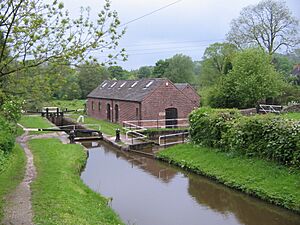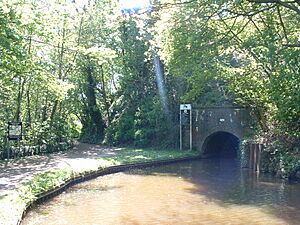Caldon Canal facts for kids
Quick facts for kids Caldon Canal |
|
|---|---|

The southern portal of Leek Tunnel
|
|
| Specifications | |
| Length | 18 miles (29 km) |
| Maximum boat length | 72 ft 0 in (21.95 m) |
| Maximum boat beam | 7 ft 0 in (2.13 m) |
| Locks | 17 |
| Status | Navigable |
| Navigation authority | Canal and River Trust |
| History | |
| Original owner | Trent & Mersey Canal Company |
| Date of act | 1776 |
| Date completed | December 1778 |
| Date restored | 1974 |
| Geography | |
| Start point | Froghall |
| End point | Etruria, Stoke-on-Trent |
| Branch(es) | Leek, Uttoxeter Canal |
| Branch of | Trent & Mersey Canal |
The Caldon Canal is a cool waterway that opened in 1779. It's actually a branch of the famous Trent and Mersey Canal. This canal stretches about 18 miles (29 km) from Etruria in Stoke-on-Trent all the way to Froghall, Staffordshire. Along its route, you'll find 17 locks, which are like water elevators for boats, and a short tunnel called Froghall Tunnel.
Contents
A Look Back: The Caldon Canal's Story
The idea for the Caldon Canal started in 1773. The company that owned the Trent & Mersey Canal wanted to build a new waterway to Leek. At first, they thought about using small boats (called tub-boats) and ramps instead of locks to change water levels. They also planned extra water storage areas (reservoirs) to keep the main canal full.
In 1776, the company got permission from Parliament to build the canal. This meant they could borrow money to fund the project. The canal was finished by December 1778. It originally had 16 locks. The company also built railways (called tramways) to carry limestone from quarries to the canal. The first tramway wasn't very successful.
Later, in 1783, they got permission for a new tramway and to make the canal a bit longer. This extension included the Froghall Tunnel.
The main Trent and Mersey Canal often ran low on water. This meant the Caldon Canal also had low water levels because its water was used to help the main canal. To fix this, the company wanted to build a big reservoir at Rudyard. To get permission, they had to include a branch canal to Leek. This plan was approved in 1797. The new Leek branch changed how the canal worked, leading to new locks being built over time.
In 1845, the Caldon Canal and other canals were bought by the North Staffordshire Railway company. They wanted canals and railways to work together. They kept most canals open, but they closed the Uttoxeter branch in 1847 to build a railway line there. The old tramway from Froghall to the quarries was replaced with a new cable railway in 1849. This railway carried huge amounts of limestone (about 1000 tons a day!) from the quarries to the canal.
Over time, more goods started moving by railway instead of canal. In 1904, a special basin was built at Endon where limestone could be easily moved from trains to boats. However, a big user of limestone closed in 1920, and the cable railway also stopped working that year. By 1930, limestone was no longer moved at Endon, and the canal became very quiet.
The Leek branch of the canal was closed in 1944. The last regular commercial boats carried coal until 1952.
However, in the late 1960s, a company called Johnson Brothers started using the canal again! They built three special barges to carry pottery from their factory to a new packaging plant. This saved them money and reduced broken items. These pottery boats continued until 1990, making it one of the last times narrowboats were used for business on the canal.
How the Canal Worked
The Caldon Canal was built mainly to carry limestone from the Caldon Low Quarries. This limestone was brought to Froghall by special tramways. Other important goods carried on the canal included coal and ironstone.
The canal faced challenges like the ground sinking in some areas due to mining. This meant a new lock, Planet Lock, had to be built to adjust the water levels. The canal gets its water from three reservoirs and the River Churnet. These reservoirs hold a lot of water, helping to keep both the Caldon Canal and the main Trent and Mersey Canal full.
Bringing the Canal Back to Life
Even though the canal was never officially closed, by the 1960s, it was almost impossible to use. People who loved canals started working to save it. Groups like the Inland Waterway Protection Society and the Caldon Canal Society pushed for its restoration.
In 1969, local councils in Staffordshire and Stoke-on-Trent agreed to help pay for the restoration. In 1971, a big boat rally was held to show how important it was to restore the canal. Then, in 1972, the government launched a program called "Operation Eyesore." This program offered money to help clean up and improve local areas.
With this help, the restoration officially began in August 1972. The main part of the canal to Froghall was fully restored by 1974. But the Caldon Canal Society wanted more! They worked to restore the Leek branch too. Volunteers helped clear the route, and the Leek branch was reopened. In 1983, the Caldon Canal and its Leek branch were officially upgraded to "Cruising Waterway" standard, meaning they were great for boats again.
In 2003, after many years of hard work, Froghall Wharf, the very end of the canal, was reopened. This included a new wharf, better facilities, and a visitor center. An old lock and basin were also reopened, creating new places for boats to stop. Much of this work was done by volunteers and with help from European funds.
Froghall Tunnel Challenge
The Froghall Tunnel has always been very low. During the 2003 restoration, the water level was lowered, and the tunnel was dug deeper. This made it 5 feet (1.5 meters) high, which is better. However, many modern boats are still too tall to pass through it. There's a special gauge at Flintmill Lock 17 to help boaters check if their boat will fit. This low height also affects plans to reopen other parts of the canal.
What You'll See: The Canal's Route
The Caldon Canal starts at Etruria, right next to the Trent & Mersey Canal. You can see a statue of James Brindley, the engineer who designed the Trent & Mersey Canal, nearby. The canal then follows the young River Trent and climbs up to a high point at Stockton Brook.
After that, the canal goes downhill through locks at Hazelhurst and Cheddleton. Near Consall Forge, the canal actually joins the River Churnet for about a mile! This is because the valley is too narrow for both the canal and the river. If the river is too high, boats can't use this section.
At Consall Forge, the canal and river separate again. The canal becomes narrower, only wide enough for one boat, and continues its peaceful journey to Froghall. The very last part of the canal includes the Froghall Tunnel, which has limited space above, and then Froghall Basin.
Other Parts: The Branches
Leek Branch
The Caldon Canal has one main branch, the Leek Branch. It's about 3 miles (4.8 km) long and includes the Leek Tunnel. This branch opened around 1800. It meets the main canal at Hazelhurst Junction, crossing over the main line on the Hazelhurst Aqueduct.
Today, the Leek Branch ends a little way from Leek town center. The original part of the canal that went right into Leek was filled in during the 1950s and 60s to build an industrial area.
In 2009, a break happened near the Leek Tunnel. This closed the end section for eight months while repairs were made. The canal was reopened in July 2010. There are plans to extend the branch back into Leek town center.
Uttoxeter Canal
Originally, the Caldon Canal also had a longer branch, about 13 miles (21 km) long, which opened in 1811. This was called the Uttoxeter Canal. It ran from Froghall all the way south to Uttoxeter and had 17 locks.
However, this canal was never very busy. In 1849, much of it was filled in by the North Staffordshire Railway Company to build a railway line. This railway line is now a preserved railway called the Churnet Valley Railway.
Further south, you can still see a few bridges and old mileposts from the Uttoxeter branch. There's even an area in Uttoxeter called "The Wharf." A group called the Caldon & Uttoxeter Canals Trust wants to reopen the Uttoxeter Branch. However, part of the old canal path is now under the JCB factory, so a new route would be needed.
Foxley Branch
There was also a much shorter branch of the Caldon Canal called the Foxley. It was about 800 yards (730 m) long and ran from Milton to Ford Green Iron Works. Today, you can find small parts of the Foxley branch in the Holden Lane Pools nature reserve. A pub called The Foxley in Milton marks where this branch used to join the main canal.
Places to See
| Point | Coordinates (Links to map resources) |
OS Grid Ref | Notes |
|---|---|---|---|
| Froghall Wharf | 53°01′35″N 1°57′45″W / 53.0265°N 1.9624°W | SK026476 | Where the Uttoxeter Canal used to join |
| Flint Mill Lock (No.17) | 53°02′00″N 1°59′45″W / 53.0333°N 1.9958°W | SK003484 | |
| Oakmeadowford Locks (No.16) | 53°02′56″N 2°01′06″W / 53.0489°N 2.0184°W | SJ988501 | |
| Woods Lock (No.15) | 53°03′37″N 2°01′45″W / 53.0603°N 2.0291°W | SJ981514 | |
| Cheddleton Locks (No.13,14) | 53°04′11″N 2°02′25″W / 53.0697°N 2.0404°W | SJ973525 | |
| Hazelhurst Top Lock (No.10) | 53°04′52″N 2°04′47″W / 53.0812°N 2.0797°W | SJ947537 | Where the Leek Branch joins |
| End of Leek Branch | 53°05′37″N 2°01′59″W / 53.0937°N 2.0331°W | SJ978551 | Aqueduct over River Churnett |
| Stockton Brook Top Lock (No.9) | 53°03′51″N 2°07′22″W / 53.0641°N 2.1228°W | SJ918518 | A group of 5 locks |
| Engine Lock (No.4) | 53°03′34″N 2°09′02″W / 53.0594°N 2.1506°W | SJ900513 | |
| Planet Lock (No.3) | 53°00′55″N 2°11′02″W / 53.0154°N 2.1838°W | SJ877464 | |
| Etruria Staircase Locks (No.1,2) | 53°01′06″N 2°11′23″W / 53.0182°N 2.1897°W | SJ873467 | |
| Etruria Junction | 53°01′12″N 2°11′38″W / 53.0200°N 2.1940°W | SJ870469 | Where it joins the Trent and Mersey Canal |





